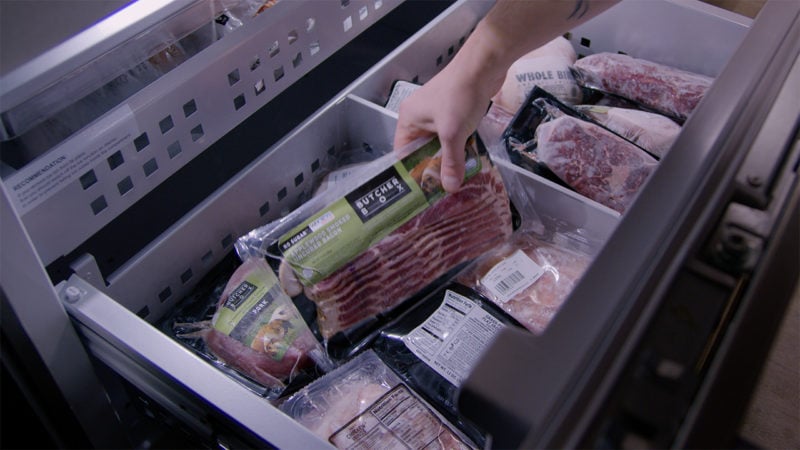Last Updated on December 14, 2023
One of life’s simple joys is to have a freezer full of ButcherBox’s delicious meat, easily accessible whenever you want an amazing meal.
But we understand that knowing exactly what to do with your frozen meat can be a little confusing. At ButcherBox, we’re lucky to have in-house meat industry experts and experienced chefs who can answer our most pressing frozen meat storage and defrosting questions. We put together this guide, to share that wisdom.
At the bottom of this post, we’ve also included some advice on what you can do to organize your meat and maximize freezer space after your frozen meat arrives on your doorstep.
What to know about defrosting in the refrigerator
The safest way to thaw frozen meat is in the refrigerator. Generally, an average size cut of meat takes a day to fully defrost in a fridge. Larger cuts or whole birds (like a turkey) take about 24 hours per five pounds to thaw.
The times mentioned below are what the USDA recommends for storing meat after it has defrosted in the fridge.
How long different proteins and cuts stay fresh in the fridge
Defrosting Chicken
Due to ButcherBox’s vacuum-seal packaging, our chicken can last between 3 to 5 days in the refrigerator. (If the vacuum seal is broken, stick to the standard 1-2 day recommendation for poultry.)
Defrosting Beef
When it comes to steaks or roasts, if the original packaging is sealed tight, it can remain in the refrigerator for almost two weeks. However, outside of its packaging or if the packaging is torn, beef is good for 3-5 days once defrosted in the refrigerator.
Ground beef is a little different. It stays fresh for 1-2 days in the fridge once it defrosts.
Defrosting Pork
The rules for pork also differ depending on the cut. Most larger pork cuts — roasts, pork butt — come in stronger, vacuum-sealed packages. Like steaks, they will remain good for up to two weeks defrosted in the refrigerator.
However, smaller cuts of pork that are in individual cut packaging will remain fresh for 3-5 days if it remains vacuum-sealed or 1-2 days if the packaging seal is broken or if you’ve removed it from its original packaging.
Once you defrost bacon, it will remain good for 7 days in the refrigerator.
Defrosting Fish
After salmon and other seafood has been defrosted, it too will be fresh for an additional one to two days if defrosted in the refrigerator. One thing to note for all seafood: Make sure you take seafood out of its packaging before you defrost it. It is not safe to defrost fish in its vacuum-sealed packaging where bacteria can form without oxygen.
Defrosting any meat outside of the refrigerator

The rules are a bit different if you defrost the meat outside of the fridge or with cold water.
Thawing Meat in Cold Water
If you want to defrost frozen meat quickly, you can do so by putting the meat in cold water — which can remain running or which you change out every 30 minutes. However, you should make sure that the packaging is sealed tightly; if not, you can put the meat in a sealed plastic bag to defrost in cold water.
Additionally, this requires active attention. You should not leave any meat in the sink indefinitely.
A one-pound cut of meat can defrost within an hour by using this cold water method.
Check out Chef Yankel’s tips for defrosting in water in the video below. (BONUS: Watch the video to the end for an easy trick to dry a steak which will lead to better a better sear and a tender steak.)
Defrosting on the Kitchen Counter? Hot Water?
It is not recommended that you defrost meat by leaving it out at room temperature on the kitchen counter, because you shouldn’t leave meat out at room temperature for more than 2 hours. This will bring it to the “danger zone” temperatures where bacteria can form. The same is true of thawing with hot water.
If you are in a pinch, you can defrost with cold running water or cook from frozen, as mentioned above.
For more on defrosting meat and other foods, check out the FDA/USDA website on defrosting, The Big Thaw.
What are you going to cook this week?
We’ve found the best step to take when you receive your ButcherBox is to first figure out which cuts you want to cook within the next five days. Those cuts can go into your refrigerator to defrost.
When you do defrost in the refrigerator, make sure to put the frozen meat on a dish or bowl or in a large, sealable bag. Sometimes, the frozen packaging gets small tears due to being jostled during shipping; this does not affect the flavor, quality, or safety of the meat. But you may have some liquid in the packaging leak as it defrosts.
Additionally, make sure to remember the different rules for defrosting seafood: It should be removed from its original vacuum-sealed packaging to defrost.
Take the rest of your frozen meat and put it right into the freezer where it can remain, frozen, for more than a year. (In theory, you can keep frozen meat indefinitely, however, for quality purposes, the USDA has some guidelines that you can find here on how long you should keep it frozen.)
We think that this is the best way to get you cooking the ButcherBox meat you want in the next few days and how to save the rest for later in the month.
Dennis Keohane is a writer, editor, and former Editorial Director for ButcherBox with a passion for storytelling and food. Combining his love for high-quality ingredients with engaging narratives, he crafts content that inspires home cooks to explore new flavors, techniques, and the joy of cooking.



